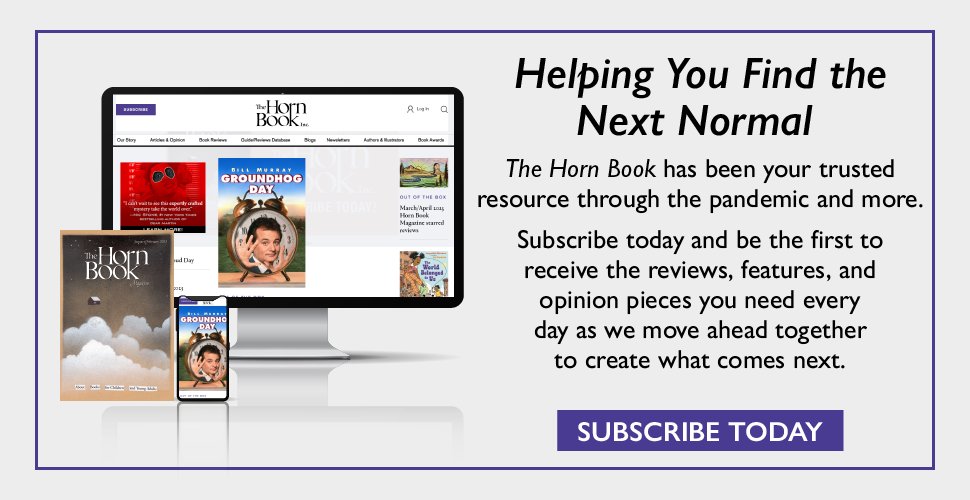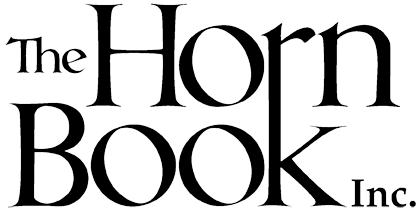John Mendelson Talks with Roger
Both John Mendelson and Nosy Crow books were longtime fixtures at Candlewick Press — John as sales director and Nosy Crow as an imprint of smart UK picture books. Here they are together again, with John as president of Nosy Crow Inc., established in Lincoln, Massachusetts, as a branch of Nosy Crow UK just one year ago.

Talks with Roger is a sponsored supplement to our free monthly e-newsletter, Notes from the Horn Book. To receive Notes, sign up here.
Sponsored by
Both John Mendelson and Nosy Crow books were longtime fixtures at Candlewick Press — John as sales director and Nosy Crow as an imprint of smart UK picture books. Here they are together again, with John as president of Nosy Crow Inc., established in Lincoln, Massachusetts, as a branch of Nosy Crow UK just one year ago.
Roger Sutton: What were you doing before Nosy Crow?
 John Mendelson: I was director of sales at Candlewick, which is how I got to know Kate Wilson, the founder of Nosy Crow. I sat on the Walker Group board, so I helped oversee the three companies: Candlewick in the U.S. and Walker in England and in Australia. Kate started Nosy Crow in 2011 in the UK, and we helped her get going by creating a Candlewick imprint mostly focused on young novelty books and a handful of picture books. The Nosy Crow list has grown and diversified since then; Kate was always clear that she wanted to go out on her own. With the sale of Candlewick to Trustbridge, I was ready for a new challenge; after I'd left Candlewick, Kate said, “I have all these books for the UK and the international markets, but I've held them back from the U.S. I need you to help shape them into a list and help me find a distributor.” I had watched Kate’s business grow stratospherically over its first decade or so before she was ready to launch this new company in the U.S., so I said, “Why don't I do that as a consultant? We'll see how things go.” That was in 2022, and we quickly realized it was going to be a good fit. We found Hachette as our distributor, and we had what were the beginnings of a publication schedule for a planned launch in May 2023. Once I realized we needed more employees, we found this beautiful light-filled office space with poured concrete floors in Lincoln, Massachusetts.
John Mendelson: I was director of sales at Candlewick, which is how I got to know Kate Wilson, the founder of Nosy Crow. I sat on the Walker Group board, so I helped oversee the three companies: Candlewick in the U.S. and Walker in England and in Australia. Kate started Nosy Crow in 2011 in the UK, and we helped her get going by creating a Candlewick imprint mostly focused on young novelty books and a handful of picture books. The Nosy Crow list has grown and diversified since then; Kate was always clear that she wanted to go out on her own. With the sale of Candlewick to Trustbridge, I was ready for a new challenge; after I'd left Candlewick, Kate said, “I have all these books for the UK and the international markets, but I've held them back from the U.S. I need you to help shape them into a list and help me find a distributor.” I had watched Kate’s business grow stratospherically over its first decade or so before she was ready to launch this new company in the U.S., so I said, “Why don't I do that as a consultant? We'll see how things go.” That was in 2022, and we quickly realized it was going to be a good fit. We found Hachette as our distributor, and we had what were the beginnings of a publication schedule for a planned launch in May 2023. Once I realized we needed more employees, we found this beautiful light-filled office space with poured concrete floors in Lincoln, Massachusetts.
RS: Your empire is starting anew.
JM: The snowball starts rolling down the hill.
RS: What goes into figuring out how to shape the list of books for the U.S.? That sounds like fun to me.
 JM: I had been an independent bookstore rep, national accounts manager, and sales director at Houghton Mifflin, selling to indies across New England and to national accounts. As sales director at Candlewick, I had access to the editorial list-shaping work — we made decisions about which Walker books we’d bring over to publish. We set up imprints like we did with Nosy Crow, and had a partnership with Templar Books, who had created the -Ology series. When I started at Nosy Crow, I thought, I'm a little intimidated by this publisher role, but finding a distributor will be easy because I know that world. In the end, the distributor conversation was much more challenging and took up a lot more time because that landscape has changed. There are fewer options. The list-shaping was fun. This book, How to Count to 1 (And Don’t Even THINK About Bigger Numbers!), was one of the first ones I gravitated to.
JM: I had been an independent bookstore rep, national accounts manager, and sales director at Houghton Mifflin, selling to indies across New England and to national accounts. As sales director at Candlewick, I had access to the editorial list-shaping work — we made decisions about which Walker books we’d bring over to publish. We set up imprints like we did with Nosy Crow, and had a partnership with Templar Books, who had created the -Ology series. When I started at Nosy Crow, I thought, I'm a little intimidated by this publisher role, but finding a distributor will be easy because I know that world. In the end, the distributor conversation was much more challenging and took up a lot more time because that landscape has changed. There are fewer options. The list-shaping was fun. This book, How to Count to 1 (And Don’t Even THINK About Bigger Numbers!), was one of the first ones I gravitated to.
RS: Oh, yeah. I was reading that this morning.
JM: I thought, My gosh, this is a great book for our market. It has to be on our launch list. It's a wonderful read aloud with an unreliable narrator children will catch onto immediately and an accessible learning-to-count aspect. But the cover was a variation of the end papers, and it didn't have a strong focal point. It felt like an activity book not a picture book. So we changed the cover. It came out in June 2023, and it has been our best-selling picture book so far. It's sold everywhere from indie bookstores to online, and it’s starting to make its way into the education market.
RS: Does it have the same cover in the UK?
JM: It didn't, but now that they've seen our success with it, they're going to reissue it in the UK in paperback with this cover. That's one of the things that I've learned as we've gone along. I know this business; I know our market. We’ve provided a different perspective to the parent company and have been able to be a catalyst for positive change and new ideas.

RS: How many of Nosy Crow’s books in the UK do you bring here? What's the percentage?
JM: It's changing every day, Roger, but remember that Nosy Crow had been in business for about twelve years at the point that we published our first book in May 2023. They had set up that imprint with Candlewick, but their business in North America had grown well beyond Candlewick, which was novelty books and some picture books. They sold nonfiction titles to Simon & Schuster, fiction series to Random House, and some one-off titles to Macmillan. There’s a big series called Unicorn Academy that went to Random House and is now on Netflix.
Last year we published thirty-five books, but Nosy Crow has close to one thousand titles in print. As we move forward, we are publishing across all of the publishing units, so young novelty books, picture books, nonfiction. There are amazing design-led, illustrator-led poetry collections like A Whale of a Time and She’ll Be the Sky: Poems by Women and Girls, which just went on sale. We changed the title for our market.
RS: What was the title there?
JM: And Everything Will Be Glad to See You, which came from a poem. I thought it was a bit of a mouthful. But we kept the same cover. Going forward, we are publishing the bulk of the new titles. I use the word publishing deliberately because we're not just distributing these books, we are running every book through our own editorial process. That might mean changing a word from lorry to truck or it might mean changing the cover or the title.
There are also books that were not conceived of when we started here. For example, Guess Who? Boo to You! is a great Halloween book. I came up with the concept, and it was executed by a UK editor and designer. It’s a great example of a real collaboration: idea generation over here, leveraging the amazing editorial, design, and production teams in the UK to make what I think is going to be a great seller for us here at Halloween. Matt Hunt’s author-illustrator debut, Up High, is another favorite of mine. We, the U.S. and the UK, worked on it together from an early stage, and that led to a handful of changes, but ones that we felt were substantive. There's an illustration, for example, of a father and son leaving their city apartment and there was a car on the “wrong” side of the road, with the steering wheel on the right, when we saw it in sketch stage.
RS: This is years ago, but I'm thinking it was Karen Lotz who told me about putting the steering wheels in more ambiguous positions so that it would be easier to go across borders.
JM: You could squint a little bit and still not really know which side it was on. Because Nosy Crow has such a great international footprint and relationships with foreign publishers, and does a lot of co-edition publishing, ideally those books can travel around the world as well as their home market.
RS: When I look back over forty years, the way British books come into this country has changed so much. Candlewick did a lot to change that, and it’s nice to see that you plan to go back and forth with your British, UK owners. It won’t all go one way.
JM: That’s the long-term goal. We published three books simultaneously in our first year; we'll publish about seventy books in 2024. New titles such as Matt Hunt’s debut and series continuations. About twenty of them will be simultaneous, so that's a big step forward. At least five or six will be created using a much more collaborative editorial process. Our first middle-grade title, Dungeon Runners, coming in September, was done the same way. Editor Jennifer Greene, who spent her career at Clarion Books, along with UK Editorial Director, Zöe Griffiths, worked jointly on the UK and American texts along with the author and illustrator to create this simultaneous edition. It's likely that our first originated books will come out in 2026 with the hope that they will be taken up by the UK and many of our international co-edition partners.
RS: How do you see the difference between publishing into schools and libraries and into the trade?
JM: Because of the partnership with Candlewick in the early days and the formats that were part of that imprint, Nosy Crow was focused more on the retail market. I'm interested in creating a wide base of sales channels. Granny Came Here on the Empire Windrush, which was on our launch list, is a story about a little girl who comes home from school with the assignment that she's got to dress up as a figure from history. She's telling this to her granny, and they go through some options, like Rosa Parks, Mary Seacole, and others. Ultimately, the girl learns about her granny's own story of being part of the seminal Windrush generation — the first major migration of African Caribbeans to the UK. The girl decides to dress as her granny to celebrate Windrush Day, which is a national holiday in the UK. When this book was first presented to me, they said, “Oh, this one is too British for you.” I said, “Wait, let me read it.” It's a touching story that happens to be illustrated by Camilla Sucre, a debut American illustrator with a Haitian background. It’s about immigration to the UK from the Caribbean, but it's a lovely story that is at its core about the immigration experience in general. I felt like it's a book that deserves to find an American audience, and it has done quite well — it got a starred review and a lot of positive coverage and has been selling into libraries — and hopefully schools down the line.
Grandpa and the Kingfisher is another example. It's an informational text about the circle of life and the natural world. Interestingly, you asked about Americanization — this is a belted kingfisher in our edition. The belted kingfisher does not exist in the UK or Northern Europe. We worked with Sarah Massini, the illustrator, and she did a separate set of illustrations for the North American edition.
What’s important to us is building a broad base of sales channels, and we accomplished that in our first year. Our books sold well between bookstores, the library market, non-traditional retailers, and mass market outlets such as Target and Walmart.
RS: I know format and shelf appeal are very important for Nosy Crow books, so I couldn't really read them properly on a screen. I’ve had that frustration when I'm looking at digital galleys, which is pretty much all I see now unless I request them.
JM: That's a challenge for us because the market has moved digitally, not just in terms of the way consumers buy books, but the way publishers sell books to retailers and librarians. Nothing replaces holding a physical sample in your hand. That being said, we do hear a lot from booksellers who say, “I took a chance on this book, and wow, I'm glad I did because I didn't realize the finished book was so beautifully produced!” That's something that also helps us stand out: we do invest a lot in the physical book.
RS: And, it is to be hoped, the library market!
JM: Oh, absolutely. Our whole marketing staff of two-and-a-half people is at PLA in Columbus, Ohio, right now. We decided to invest more in conferences this year, to get out there and let not only booksellers but librarians and teachers see and touch our books. To have those connections, to understand what their opportunities are, what their challenges are — obviously, books are under threat in many places in this country. Not only do we see conferences as an opportunity for us to showcase our wares, as it were, but also to hear about ways we can help support teachers and librarians and booksellers.
Sponsored by
ALREADY A SUBSCRIBER? LOG IN
We are currently offering this content for free. Sign up now to activate your personal profile, where you can save articles for future viewing.








Add Comment :-
Comment Policy:
Comment should not be empty !!!